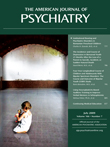Persistent Psychosis Associated With Salvia Divinorum Use
To The Editor: Salvia divinorum (salvia) is a sage plant that is easily obtained in the United States. Its active ingredient, Salvinorin A, is a novel and highly selective pure kappa opiate receptor agonist with rapid onset and powerful hallucinogenic properties (1) . Salvia has become increasingly popular as a drug of abuse when smoked. No long-term negative outcomes have been reported from the use of salvia. We present a case in which salvia precipitated persistent psychosis.
“Mr. J” was a 21-year-old man with no family or personal psychiatric history or laboratory abnormalities. He was reported to have normal social interactions, behavior, and cognitive skills. He was transferred to our psychiatric unit for acute psychosis and paranoia, which occurred shortly after smoking salvia. In transport, the patient became suspicious and attempted to jump from the vehicle. Upon presentation, he demonstrated echolalia, paranoia, flight of ideas, and psychomotor agitation. The patient remained agitated for the first 2 days of hospitalization. He attempted to barricade himself in his room. Risperidone (3 mg by mouth/three times per day) was administered, and the patient was eventually stabilized. The dosage, however, resulted in the parkisonian features of rigidity, bradykinesia, and masked facies.
Mr. J was transferred to the chemical dependency unit for further treatment. He was stabilized, and treatment with risperidone was slowly tapered. During the taper from risperidone, the patient continued to improve and manifested better insight and logical thought processes. He participated in group therapy and interacted with peers, and the parkinsonian features subsided. One day after risperidone was withdrawn, the patient’s symptoms abruptly returned. He became agitated, paranoid, and aggressive and believed he was able to project and receive thoughts. He returned to the inpatient psychiatry unit where risperidone (3 mg by mouth/twice daily) was reinstated. He was once again stabilized and transferred to the referring psychiatric facility for further treatment. At the 4-month follow-up, the patient exhibited no perceptible improvement.
To the best of our knowledge, this is the first reported case of a persistent negative outcome from the use of salvia. We suspect that our patient was genetically predisposed to schizophrenia, and salvia precipitated the clinical manifestations. This may relate to the drug’s ability to influence dopamine levels in the brain and potentiate plastic changes in frontal lobe networks (3) .
Previous studies have cited salvia as a potential treatment option for CNS illnesses (2) . This is surprising, considering the paucity of research regarding its efficacy. Salvia’s ability to increase dopamine levels in the nucleus accumbens increases its potential for dependence. Consistently, patients at our clinic who have used the drug report that its psychological effects are abrupt and frightening. Clinicians should be aware that salvia use can be associated with psychiatric illness.
1. Prisinzano T: Psychopharmacology of the hallucinogenic sage Salvia divinorum. Life Sci 2005; 78:527–531Google Scholar
2. Grudmann O, Phipps SM, Zadezensky I, Butterweck V: Salvia divinorum and salvinorin A: an update on pharmacology and analytical methodology. Planta Med 2007; 10:1039–1046Google Scholar
3. Braida D, Limonta V, Capurro V, Fadda P, Fadda P, Rubino T, Mascia P, Zani A, Gori E, Fratta W, Parolaro D, Sala M: Involvement of kappa-opioid and endocannabinoid system on salvia A-induced reward. J Biol Psychiatry 2008; 3:286–292Google Scholar



